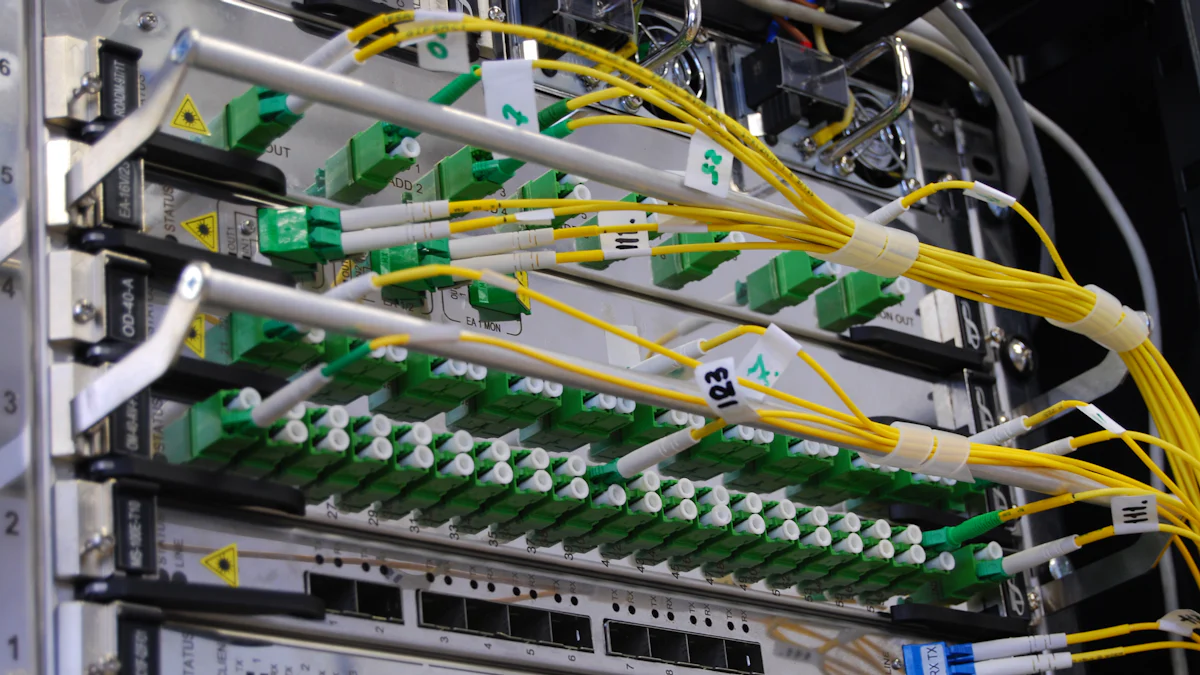Exploring ESTEL's Delta rectifier module trends in 2025

In 2025, delta rectifier module technology has reached new heights, revolutionizing industries like electric vehicles. You can now experience advanced features such as AI-driven optimization, modular designs for flexible setups, and real-time performance monitoring. These innovations are not just concepts—they’re driving a market projected to grow from USD 3.2 billion in 2023 to USD 5.6 billion by 2032, expanding at a 6.5% CAGR. ESTEL leads this transformation, delivering cutting-edge solutions that redefine efficiency and reliability in automotive power electronics.
Key Takeaways
Delta rectifier modules in 2025 use AI to work better. They improve how electric vehicles run and last longer.
Modular designs make them easy to fix and expand. This makes them great for many types of vehicles and uses.
Real-time monitoring checks performance and keeps power steady. It also helps avoid delays by reducing downtime.
ESTEL's new ideas make energy conversion over 98% efficient. This saves a lot of energy for businesses.
Using ESTEL's technology helps the planet by being eco-friendly. It supports the move to cleaner energy worldwide.
Overview of Delta Rectifier Module Technology in 2025

Key advancements in Delta rectifier module technology
Delta rectifier modules have undergone significant technological advancements in 2025, making them indispensable in industries like automotive and renewable energy. These modules now feature cutting-edge designs that prioritize efficiency, modularity, and adaptability. One of the most notable breakthroughs is the integration of AI-driven optimization. This allows the modules to analyze performance data in real time, ensuring maximum efficiency and reliability. For example, AI algorithms can predict potential failures and adjust operations to prevent downtime.
Another major advancement is the use of modular designs. These designs enable you to scale systems easily, whether you're working on a small electric vehicle or a large hybrid electric vehicle. Modularity also simplifies maintenance, as individual components can be replaced without disrupting the entire system. Additionally, real-time monitoring capabilities have become a standard feature. This innovation allows you to track performance metrics, such as voltage and current, ensuring stable and consistent power delivery.
Historical milestones also highlight the evolution of delta rectifier modules. For instance, the introduction of switch mode power supplies in 1980 revolutionized efficiency and power density. Later, the launch of the Flatpack2 in 2005 brought a new form factor with improved power density. By 2017, the Flatpack SHE achieved near-theoretical maximum conversion efficiency, setting a benchmark for future innovations. These advancements have paved the way for the highly efficient and adaptable modules you see today.
Trends shaping the automotive power electronics market
The automotive power electronics market in 2025 is shaped by several key trends, driven by the growing demand for electric vehicles and hybrid vehicles. One of the most significant trends is the increasing adoption of electric and hybrid electric vehicles. Governments worldwide are implementing regulations to promote sustainable transportation, accelerating the shift toward electrification. As a result, automakers are investing heavily in power electronics technologies to meet these demands.
Another trend is the rising electronics content in traditional internal combustion engine vehicles. Even as the industry transitions to electric vehicles, manufacturers are enhancing the efficiency and functionality of internal combustion engines with advanced power electronics. This ensures a smoother transition while catering to diverse consumer needs.
Market data underscores the importance of these trends. In 2023, the automotive power semiconductor market was valued at USD 59.30 billion. It is projected to grow at a rate of 6.2% from 2024 to 2030, reaching nearly USD 90.35 billion. This growth reflects the increasing reliance on power electronics in both electric and hybrid vehicles. Additionally, innovations like the SVD-MPEMC controller have demonstrated the ability to reduce harmonics and maintain linear responses, ensuring stable performance across various operational phases.
As you explore these trends, it's clear that delta rectifier modules play a crucial role in shaping the future of the automotive industry. Their ability to deliver efficient, reliable, and scalable power solutions makes them a cornerstone of modern automotive technology.
ESTEL's Leadership in Delta Rectifier Module Technology
ESTEL's specific innovations in 2025
You’ll find ESTEL at the forefront of innovation in the automotive power electronics market. In 2025, ESTEL introduced groundbreaking advancements in delta rectifier module technology that redefine how industries approach power management. One of their most notable innovations is the integration of advanced AI-driven automation. This feature enables real-time performance analysis and predictive maintenance, ensuring uninterrupted operation and reducing downtime.
Another key innovation is the development of ultra-modular delta rectifier modules. These modules allow you to customize configurations for diverse applications, from electric vehicles to hybrid electric vehicles. Their modularity simplifies system scaling and maintenance, making them ideal for industries requiring flexible solutions.
ESTEL also focused on enhancing energy efficiency. Their latest modules achieve conversion efficiencies exceeding 98%, setting a new benchmark in the automotive power electronics industry. This improvement not only reduces energy waste but also supports sustainable practices across industries.
In addition to these advancements, ESTEL has expanded its product line to cater to industrial automation solutions. Their rectifier modules now integrate seamlessly with automation systems, enabling precise control and monitoring of power delivery. This innovation supports industries like manufacturing and infrastructure, where reliable power is critical.
Tip: ESTEL’s innovations in 2025 demonstrate their commitment to pushing the boundaries of technology while addressing the evolving needs of the automotive and industrial sectors.
Comparison of ESTEL's technology with competitors
When you compare ESTEL’s delta rectifier modules to those of competitors, their superiority becomes evident. ESTEL’s focus on modularity and automation gives them a distinct edge in the automotive power electronics market. Competitors often struggle to match the scalability and adaptability of ESTEL’s ultra-modular designs.
For instance, while some competitors offer AI-enabled modules, ESTEL’s AI-driven automation goes further by integrating predictive analytics and self-optimization capabilities. This ensures consistent performance and reduces maintenance costs, which are critical for industries relying on hybrid vehicles and electric vehicles.
Efficiency is another area where ESTEL outshines its rivals. Many competitors achieve conversion efficiencies in the range of 94–96%, but ESTEL’s modules consistently exceed 98%. This difference translates into significant energy savings and lower operational costs for industries adopting ESTEL’s solutions.
A comparison table highlights these distinctions:
Feature | ESTEL’s Delta Rectifier Modules | Competitors’ Modules |
|---|---|---|
Modularity | Ultra-modular designs | Limited modular options |
AI Integration | Predictive analytics & self-optimization | Basic AI capabilities |
Conversion Efficiency | >98% | 94–96% |
Applications | Automotive, hybrid vehicles, industrial automation solutions | Primarily automotive |
ESTEL’s commitment to innovation and adaptability ensures their solutions remain unmatched in the automotive power electronics industry. Their ability to address diverse needs, from hybrid electric vehicles to infrastructure projects, solidifies their position as a market leader.
Applications and Benefits of ESTEL's Delta Rectifier Modules

Real-world applications in the automotive power electronics market
ESTEL's Delta rectifier modules have become essential in the automotive power electronics market. You can find these modules powering electric vehicles and hybrid electric vehicles, ensuring efficient energy conversion and reliable performance. Their modular design allows automakers to scale systems for different vehicle types, from compact cars to large hybrid vehicles. This adaptability has made them a preferred choice for manufacturers aiming to meet the growing demand for electrified powertrains.
In addition to vehicles, these modules play a critical role in charging infrastructure. With the rise in electric car sales, the need for efficient charging solutions has skyrocketed. ESTEL's modules support smart charging features, enabling faster and more reliable charging for electric vehicles. This innovation ensures that charging stations can handle high demand without compromising performance.
Beyond automotive applications, ESTEL's modules are also used in industrial automation solutions. Their ability to integrate seamlessly with automation systems makes them ideal for industries requiring precise power management. For example, manufacturing plants and infrastructure projects benefit from their reliability and energy efficiency, ensuring uninterrupted operations.
Benefits for industries adopting ESTEL's advancements
By adopting ESTEL's advancements, industries gain access to cutting-edge technology that enhances performance and reduces costs. The high energy efficiency of these modules minimizes power loss, translating into significant savings for businesses. Their modularity simplifies maintenance, reducing downtime and ensuring consistent operations.
Industries also benefit from the automation capabilities of ESTEL's modules. Real-time monitoring and predictive analytics allow you to identify potential issues before they escalate. This proactive approach reduces maintenance costs and improves system reliability. For example, automotive manufacturers can ensure that their vehicles deliver consistent performance, enhancing customer satisfaction.
Client testimonials highlight the impact of ESTEL's innovations. Sarah M. from New York shared how ESTEL's products improved her experience, while Carlos L. from Madrid praised their consistent quality. These real-world examples demonstrate the tangible benefits of adopting ESTEL's technology across various sectors.
Delta rectifier module technology in 2025 has transformed the automotive industry. You now benefit from AI-driven optimization, modular designs, and real-time monitoring. ESTEL has led these advancements, setting new standards in the automotive power electronics market. Their ultra-modular designs and high-efficiency modules redefine power management for electric and hybrid vehicles.
Looking ahead, Delta rectifier modules will play a vital role in sustainable energy solutions. Their ability to deliver efficient and reliable power will support the global shift toward greener technologies. By adopting these innovations, you contribute to a more sustainable future.
FAQ
What makes ESTEL's Delta rectifier modules unique?
ESTEL's modules stand out due to their ultra-modular design and AI-driven automation. These features allow you to customize configurations, improve efficiency, and reduce downtime. Their ability to integrate seamlessly into various systems makes them a preferred choice in the automotive industry.
How do Delta rectifier modules improve energy efficiency?
Delta rectifier modules optimize energy conversion, achieving efficiencies above 98%. This reduces energy waste and operational costs. By adopting these modules, you ensure reliable power delivery while supporting sustainable practices in industries like automotive and manufacturing.
Can ESTEL's modules be used outside the automotive sector?
Yes, ESTEL's modules are versatile. You can use them in industrial automation, renewable energy systems, and charging infrastructure. Their adaptability and reliability make them suitable for diverse applications requiring precise power management.
Why is modularity important in Delta rectifier modules?
Modularity allows you to scale systems easily and replace components without disrupting operations. This flexibility is especially valuable in automotive applications, where different vehicle types require tailored power solutions.
How does AI integration benefit Delta rectifier modules?
AI integration enables real-time monitoring and predictive maintenance. This helps you identify potential issues early, ensuring uninterrupted performance. It also optimizes operations, reducing energy consumption and maintenance costs.
See Also
Ensuring Correct Voltage Levels in ESTEL Communication Cabinets
Telecom Cabinet Energy Storage System with ESTEL Smart Microgrid
Understanding the Power System of ESTEL Telecom Cabinets
Batteries for Energy Storage in ESTEL Telecom Cabinets
Industrial Applications of ESTEL's Cabinet Cooling Solutions
CALL US DIRECTLY
86-13752765943
3A-8, SHUIWAN 1979 SQUARE (PHASE II), NO.111, TAIZI ROAD,SHUIWAN COMMUNITY, ZHAOSHANG STREET, NANSHAN DISTRICT, SHENZHEN, GUANGDONG, CHINA


